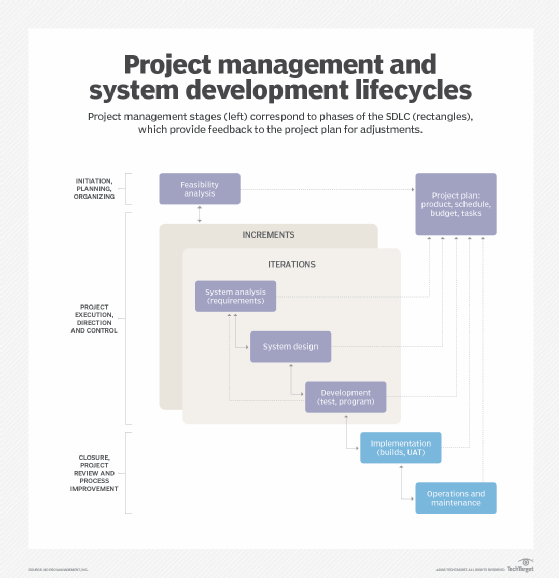iterative development
What is iterative development?
Iterative development is a way of breaking down the software development lifecycle (SDLC) of a large application into smaller chunks. It is typically used in conjunction with incremental development in which a longer SDLC is split into smaller segments that build upon each other.
In iterative development, feature code is designed, developed and tested in repeated cycles. These cycles or iterations (also known as sprints) give the concept its name. With each iteration, additional features can be designed, developed and tested to add to the program's functionality. These iterations continue until a fully functional software application is created and ready for deployment to customers or end users.

Iterative development is a key practice in agile development methodologies where sprints are time-boxed (i.e., limited to a certain amount of time, such as two weeks). At the end of each iteration, working code that can be demonstrated for a customer is available.
The methodology is suitable for large software projects where complexity is a major challenge. Iterative development can also be implemented effectively when project requirements are easy to understand or likely to change in future.
Iterative development vs. traditional development
Iterative development contrasts with the traditional waterfall model of development in which each phase of the SDLC is carried out in a step-by-step manner. With the waterfall method, coding doesn't begin until the design of the entire software application design is complete and has gone through a phase gate review. Likewise, testing doesn't begin until coding is complete and has passed necessary reviews.
The iterative method is cyclical, meaning each iteration includes planning, design, development and testing activities. Further, all these activities or stages are repeated as features are added individually in each iteration to add to the product or improve its functionality. The end of each iteration results in a working product with a more advanced functionality compared to the product of the previous iteration.
The purpose of working iteratively is to allow more flexibility for changes. When the requirements and design of a major application are done using a traditional methodology (sometimes referred to as big design up front), there can be problems that don't surface until development begins. By working iteratively, the project team goes through a cycle where they evaluate each iteration and determine what changes are needed to produce a satisfactory product.
Benefits of iterative development
Iterative development simplifies the SDLC by breaking down the entire effort into smaller, more manageable chunks. Since the code is developed and tested in repeated iterations, it lets new features be added to the product and tested before implementation.
With traditional methods, issues often arise later in the SDLC, and problems might surface only during the development or testing phases. If the planned deployment is imminent, developers may not have enough time to fix the problems or incorporate other necessary changes in time.
Iterative development can eliminate many of those issues and allows more flexibility and adaptability in the SDLC. Developers can incorporate user feedback, which is based on an actual working product and not just technical specifications, and make changes to improve the product. These improvements happen during successive iterations instead of toward the end of the SDLC, when deadline pressures are high. Developers can also easily adapt to changes without substantially adding to development time or causing delays.
Developers can also evaluate progress in one stage before proceeding to the next. Iterations are time-boxed, so they must complete a particular development cycle and deliver working code within a certain period. These boundaries keep the project on track and help developers focus on product design and quality.
Versioning is another benefit of iterative development. Since every new iteration is an improved version of the previous iteration, it's easy to maintain discrete versions of the software along with team accountability. Developers can also roll back to previous iterations with minimal losses if the current iteration fails.

Iterative development phases
The cyclical iterative development process consists of four general phases:
- Phase 1: Planning and analysis. In the initial step, developers identify and analyze the software product's requirements in line with business goals. They also create any required database models and business logic to support development.
- Phase 2: Design. During the design phase, the team establishes various technical requirements for the project, such as programming languages, data layers, etc.
- Phase 3: Technical architecture and coding. In the third phase, the team builds the technical architecture and starts coding to build the first version (first iteration module) of the software.
- Phase 4: Testing. The fourth step in the process involves testers checking the code for bugs or errors. They perform both unit testing, where individual code units are tested, and integration testing, where they confirm that all the units are functioning properly when integrated. Testing also includes user acceptance testing (UAT) to ensure that the product is aligned with the user requirements for that iteration and security testing using either black box, white box or gray box testing methods.

All phases are repeated for each iteration until the final product is ready for delivery. Prior to actual delivery, the team evaluates the entire product and hands it to the client for review.
Explore functional vs. nonfunctional requirements in software engineering.




